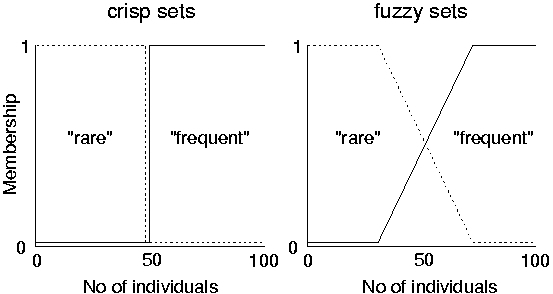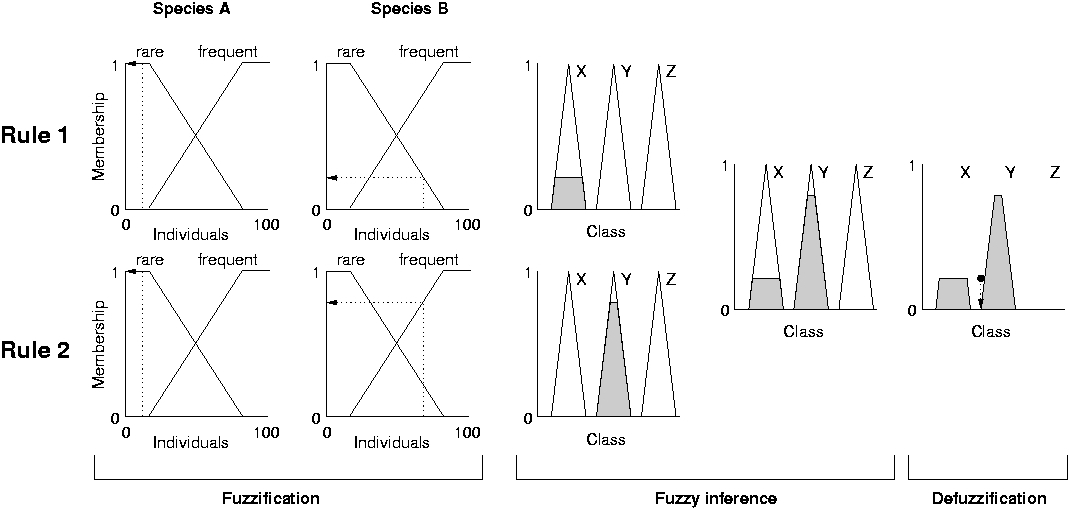Species
|
Prefered habitat types
|
Ecological tolerance
|
Trophic Guild
|
Feeding Items
|
Abax parallelepipedus (Piller & Mitterpacher,
1783)
|
moist deciduous forests
|
stenotopic a
|
carnivorous
|
|
Acupalpus dubius Schilsky, 1888
|
vegetationless river banks
|
stenotopic a
|
unclear
|
|
Acupalpus flavicollis (Sturm, 1825)
|
vegetationless river banks
|
intermediate c
|
unclear
|
|
Acupalpus parvulus (Sturm, 1825)
|
vegetationless river banks
|
stenotopic a
|
unclear
|
|
Agonum afrum (Duftschmid, 1812)
|
eutrophic mires
|
stenotopic a
|
mainly carnivorous
|
|
Agonum fuliginosum (Panzer, 1809)
|
wet forests (incl. floodplains)
|
intermediate c
|
carnivorous
|
Collembola
|
Agonum gracile (Gyllenhal, 1827)
|
oligotrophic or mesotrophic mires
|
stenotopic a
|
mainly carnivorous
|
|
Agonum piceum (Linnaeus, 1758)
|
eutrophic mires
|
stenotopic a
|
mainly carnivorous
|
|
Agonum sexpunctatum (Linnaeus, 1758)
|
oligotrophic or mesotrophic mires
|
intermediate c
|
mainly carnivorous
|
|
Agonum thoreyi Dejean, 1828
|
eutrophic mires
|
intermediate c
|
mainly carnivorous
|
|
Agonum versutum (Gyllenhal, 1827)
|
eutrophic mires
|
intermediate c
|
mainly carnivorous
|
|
Agonum viduum (Panzer, 1797)
|
eutrophic mires
|
stenotopic a
|
mainly carnivorous
|
|
Amara aenea (De Geer, 1774)
|
dry grasslands
|
intermediate c
|
herbivorous, carnivorous
|
seeds, soft roots, insects, small worms
|
Amara aulica (Panzer, 1797)
|
ruderal sites (incl. fallows)
|
intermediate c
|
herbivorous
|
seeds
|
Amara bifrons (Gyllenhal, 1810)
|
ruderal sites (incl. fallows)
|
intermediate c
|
herbivorous, carnivorous
|
seeds, soft roots, insects, small worms
|
Amara brunnea (Gyllenhal, 1810)
|
drier deciduous or coniferous
forests
|
intermediate c
|
herbivorous, carnivorous
|
seeds, soft roots, insects, small worms
|
Amara communis (Panzer, 1797)
|
fresh, intensively managed meadows
or pastures
|
eurytopic b
|
herbivorous
|
seeds
|
Amara consularis (Duftschmid, 1812)
|
arable land
|
intermediate c
|
herbivorous
|
seeds
|
Amara convexior Stephens, 1828
|
dry grasslands
|
intermediate c
|
herbivorous, carnivorous
|
seeds, soft roots, insects, small worms
|
Amara familiaris (Duftschmid, 1812)
|
arable land
|
intermediate c
|
herbivorous
|
seeds
|
Amara lunicollis Schiödte, 1837
|
dry grasslands
|
intermediate c
|
herbivorous, carnivorous
|
seeds, soft roots, insects, small worms
|
Amara ovata (Fabricius, 1792)
|
moist deciduous forests
|
intermediate c
|
herbivorous, carnivorous
|
seeds, soft roots, insects, small worms
|
Amara plebeja (Gyllenhal, 1810)
|
arable land
|
eurytopic b
|
herbivorous
|
seeds
|
Amara similata (Gyllenhal, 1810)
|
arable land
|
intermediate c
|
herbivorous, carnivorous
|
seeds, soft roots, insects, small worms
|
Amara spreta Dejean, 1831
|
arable land
|
intermediate c
|
herbivorous, carnivorous
|
seeds, soft roots, insects, small worms
|
Amara tibialis (Paykull, 1798)
|
dry grasslands
|
intermediate c
|
herbivorous, carnivorous
|
seeds, soft roots, insects, small worms
|
Anisodactylus binotatus (Fabricius, 1787)
|
unmanaged moist or wet meadows
|
intermediate c
|
unclear
|
|
Anthracus consputus (Duftschmid, 1812)
|
eutrophic mires
|
intermediate c
|
unclear
|
|
Badister bullatus (Schrank, 1798)
|
drier deciduous or coniferous
forests
|
intermediate c
|
unclear
|
|
Badister dilatatus Chaudoir, 1827
|
oligotrophic or mesotrophic mires
|
intermediate c
|
unclear
|
|
Badister lacertosus Sturm, 1815
|
moist deciduous forests
|
intermediate c
|
unclear
|
|
Badister sodalis (Duftschmid, 1812)
|
unmanaged moist or wet meadows
|
intermediate c
|
unclear
|
|
Bembidion articulatum (Panzer, 1796)
|
unmanaged moist or wet meadows
|
intermediate c
|
unclear
|
d
|
Bembidion assimile Gyllenhal, 1810
|
eutrophic mires
|
intermediate c
|
unclear
|
d
|
Bembidion biguttatum (Fabricius, 1779)
|
eutrophic mires
|
intermediate c
|
unclear
|
d
|
Bembidion doris (Panzer, 1797)
|
oligotrophic or mesotrophic mires
|
intermediate c
|
unclear
|
d
|
Bembidion gilvipes Sturm, 1825
|
unmanaged moist or wet meadows
|
intermediate c
|
unclear
|
d
|
Bembidion guttula (Fabricius, 1792)
|
eutrophic mires
|
intermediate c
|
unclear
|
d
|
Bembidion humerale Sturm, 1825
|
oligotrophic or mesotrophic mires
|
stenotopic a
|
unclear
|
d
|
Bembidion lampros (Herbst, 1784)
|
arable land
|
intermediate c
|
unclear
|
d
|
Bembidion mannerheimii C.R. Sahlberg, 1827
|
wet forests (incl. floodplains)
|
intermediate c
|
unclear
|
d
|
Bembidion properans Stephens, 1829
|
arable land
|
intermediate c
|
unclear
|
d
|
Bembidion tetracolum Say, 1823
|
arable land
|
intermediate c
|
unclear
|
d
|
Bembidion varium (Olivier, 1795)
|
vegetationless river banks
|
intermediate c
|
carnivorous
|
Nematoda, insect larvae
|
Blethisa multipunctata (Linnaeus, 1758)
|
eutrophic mires
|
intermediate c
|
unclear
|
|
Bradycellus csikii Laczó, 1912
|
ruderal sites (incl. fallows)
|
intermediate c
|
unclear
|
|
Bradycellus harpalinus (Serville, 1821)
|
oligotrophic or mesotrophic mires
|
intermediate c
|
herbivorous
|
seeds
|
Broscus cephalotes (Linnaeus, 1758)
|
arable land
|
intermediate c
|
carnivorous
|
|
Calathus fuscipes (Goeze, 1777)
|
ruderal sites (incl. fallows)
|
intermediate c
|
herbivorous
|
seeds, germinating pine seeds
|
Calathus melanocephalus (Linnaeus, 1758)
|
ruderal sites (incl. fallows)
|
intermediate c
|
herbivorous
|
seeds
|
Calathus micropterus (Duftschmid, 1812)
|
drier deciduous or coniferous
forests
|
stenotopic a
|
unclear
|
|
Calathus rotundicollis Dejean, 1828
|
moist deciduous forests
|
intermediate c
|
unclear
|
|
Carabus granulatus Linnaeus, 1758
|
wet forests (incl. floodplains)
|
eurytopic b
|
carnivorous
|
insects, larvae
|
Carabus hortensis Linnaeus, 1758
|
moist deciduous forests
|
stenotopic a
|
carnivorous
|
insects, snails, fresh carrion
|
Carabus nemoralis O.F. Müller, 1764
|
moist deciduous forests
|
intermediate c
|
carnivorous, herbivorous
|
insects, snails, worms, fresh fruit
|
Carabus violaceus Linnaeus, 1758
|
drier deciduous or coniferous
forests
|
intermediate c
|
mainly carnivorous
|
snails, fresh carrion, mushrooms
|
Chlaenius nigricornis (Fabricius, 1787)
|
eutrophic mires
|
stenotopic a
|
unclear
|
|
Chlaenius tristis (Schaller, 1783)
|
eutrophic mires
|
stenotopic a
|
unclear
|
|
Clivina fossor (Linnaeus, 1758)
|
arable land
|
intermediate c
|
mainly carnivorous
|
|
Cychrus caraboides (Linnaeus, 1758)
|
moist deciduous forests
|
intermediate c
|
carnivorous
|
snails, worms
|
Dromius sigma (Rossi, 1790)
|
wet forests (incl. floodplains)
|
intermediate c
|
unclear
|
|
Dyschirius aeneus (Dejean, 1825)
|
vegetationless river banks
|
stenotopic a
|
carnivorous
|
Staphilinidae and their larvae
|
Dyschirius globosus (Herbst, 1783)
|
wet forests (incl. floodplains)
|
eurytopic b
|
carnivorous
|
Staphilinidae and their larvae
|
Dyschirius luedersi Wagner, 1915
|
eutrophic mires
|
intermediate c
|
carnivorous
|
Staphilinidae and their larvae
|
Elaphrus cupreus Duftschmid, 1812
|
wet forests (incl. floodplains)
|
intermediate c
|
carnivorous
|
|
Elaphrus riparius (Linnaeus, 1758)
|
vegetationless river banks
|
stenotopic a
|
carnivorous
|
|
Elaphrus uliginosus Fabricius, 1775
|
eutrophic mires
|
intermediate c
|
carnivorous
|
|
Epaphius rivularis (Gyllenhal, 1810)
|
oligotrophic or mesotrophic mires
|
intermediate c
|
unclear
|
|
Epaphius secalis (Paykull, 1790)
|
wet forests (incl. floodplains)
|
stenotopic a
|
unclear
|
|
Harpalus affinis (Schrank, 1781)
|
arable land
|
intermediate c
|
herbivorous
|
seeds of deciduous and coniferous trees
|
Harpalus anxius (Duftschmid, 1812)
|
dry grasslands
|
intermediate c
|
mainly herbivorous
|
|
Harpalus distinguendus (Duftschmid, 1812)
|
arable land
|
stenotopic a
|
herbivorous
|
|
Harpalus latus (Linnaeus, 1758)
|
fresh, intensively managed meadows
or pastures
|
intermediate c
|
mainly herbivorous
|
|
Harpalus rufipalpis Sturm, 1818
|
dry grasslands
|
intermediate c
|
mainly herbivorous
|
|
Harpalus signaticornis (Duftschmid, 1812)
|
arable land
|
intermediate c
|
mainly herbivorous
|
|
Harpalus smaragdinus (Duftschmid, 1812)
|
dry grasslands
|
intermediate c
|
mainly herbivorous
|
|
Harpalus tardus (Panzer, 1797)
|
ruderal sites (incl. fallows)
|
intermediate c
|
herbivorous
|
|
Harpalus xanthopus winkleri Schauberger,
1923
|
moist deciduous forests
|
intermediate c
|
mainly herbivorous
|
|
Leistus ferrugineus (Linnaeus, 1758)
|
drier deciduous or coniferous
forests
|
intermediate c
|
carnivorous
|
Collembola
|
Leistus rufomarginatus Duftschmid, 1812
|
moist deciduous forests
|
intermediate c
|
carnivorous
|
Collembola
|
Leistus terminatus (Hellwig in Panzer, 1793)
|
oligotrophic or mesotrophic mires
|
intermediate c
|
carnivorous
|
Collembola
|
Loricera pilicornis (Fabricius, 1775)
|
arable land
|
eurytopic b
|
carnivorous
|
Collembola
|
Microlestes minutulus (Goeze, 1777)
|
ruderal sites (incl. fallows)
|
intermediate c
|
unclear
|
|
Nebria brevicollis (Fabricius, 1792)
|
moist deciduous forests
|
eurytopic b
|
carnivorous
|
Collembola
|
Notiophilus aquaticus (Linnaeus, 1758)
|
dry grasslands
|
stenotopic a
|
carnivorous
|
Collembola, mites
|
Notiophilus biguttatus (Fabricius, 1779)
|
moist deciduous forests
|
intermediate c
|
carnivorous
|
Collembola, mites
|
Notiophilus palustris (Duftschmid, 1812)
|
wet forests (incl. floodplains)
|
intermediate c
|
carnivorous
|
Collembola, mites
|
Oodes helopioides (Fabricius, 1792)
|
eutrophic mires
|
intermediate c
|
unclear
|
|
Oxypselaphus obscurus (Herbst, 1794)
|
wet forests (incl. floodplains)
|
intermediate c
|
unclear
|
|
Panagaeus cruxmajor (Linnaeus, 1758)
|
eutrophic mires
|
stenotopic a
|
unclear
|
|
Patrobus assimilis Chaudoir, 1844
|
oligotrophic or mesotrophic mires
|
stenotopic a
|
unclear
|
|
Patrobus atrorufus (Stroem, 1768)
|
wet forests (incl. floodplains)
|
intermediate c
|
unclear
|
|
Poecilus cupreus (Linnaeus, 1758)
|
arable land
|
intermediate c
|
carnivorous
|
|
Poecilus versicolor (Sturm, 1824)
|
arable land
|
intermediate c
|
carnivorous
|
|
Pseudoophonus rufipes (De Geer, 1774)
|
arable land
|
intermediate c
|
carnivorous, herbivorous
|
|
Pterostichus anthracinus (Illiger, 1798)
|
wet forests (incl. floodplains)
|
intermediate c
|
carnivorous
|
|
Pterostichus aterrimus (Herbst, 1794)
|
oligotrophic or mesotrophic mires
|
stenotopic a
|
carnivorous
|
|
Pterostichus diligens (Sturm, 1824)
|
oligotrophic or mesotrophic mires
|
intermediate c
|
carnivorous
|
|
Pterostichus guentheri Sturm, 1824
|
eutrophic mires
|
intermediate c
|
carnivorous
|
|
Pterostichus melanarius (Illiger, 1798)
|
fresh, intensively managed meadows
or pastures
|
eurytopic b
|
carnivorous, herbivorous
|
insects, cereals, fruit
|
Pterostichus minor (Gyllenhal, 1827)
|
oligotrophic or mesotrophic mires
|
intermediate c
|
carnivorous
|
|
Pterostichus niger (Schaller, 1783)
|
moist deciduous forests
|
eurytopic b
|
carnivorous
|
|
Pterostichus nigrita (Paykull, 1790)
|
wet forests (incl. floodplains)
|
intermediate c
|
carnivorous
|
|
Pterostichus oblongopunctatus (Fabricius,
1787)
|
moist deciduous forests
|
intermediate c
|
carnivorous
|
|
Pterostichus rhaeticus Heer, 1837
|
oligotrophic or mesotrophic mires
|
intermediate c
|
carnivorous
|
|
Pterostichus strenuus (Panzer, 1797)
|
moist deciduous forests
|
intermediate c
|
carnivorous, herbivorous
|
insects, rotting plants
|
Pterostichus vernalis (Panzer, 1796)
|
unmanaged noist or wet meadows
|
intermediate c
|
carnivorous
|
|
Stenolophus mixtus (Herbst, 1784-1785)
|
eutrophic mires
|
intermediate c
|
unclear
|
|
Stenolophus teutonus (Schrank, 1781)
|
vegetationless river banks
|
intermediate c
|
unclear
|
|
Stomis pumicatus (Panzer, 1796)
|
moist deciduous forests
|
intermediate c
|
unclear
|
|
Syntomus truncatellus (Linné, 1761)
|
ruderal sites (incl. fallows)
|
intermediate c
|
unclear
|
|
Synuchus vivalis (Illigier, 1798)
|
ruderal sites (incl. fallows)
|
intermediate c
|
unclear
|
|
Trechoblemus micros (Herbst, 1783)
|
eutrophic mires
|
intermediate c
|
unclear
|
|
Trechus obtusus Erichson, 1837
|
ruderal sites (incl. fallows)
|
intermediate c
|
unclear
|
|
Trechus quadristriatus (Schrank, 1781)
|
arable land
|
intermediate c
|
unclear
|
|
Trichocellus placidus (Gyllenhal, 1827)
|
wet forests (incl. floodplains)
|
intermediate c
|
unclear
|
|
Zabrus tenebrioides (Goeze, 1777)
|
arable land
|
stenotopic a
|
herbivorous, carnivorous
|
cereals, young plants
|

